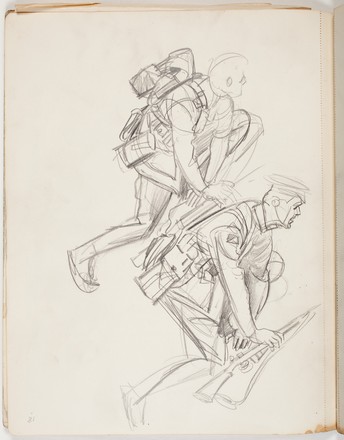Sketchbook with horse and figure studies
1918–19
Pencil, ink and charcoal drawings on paper
Bequest of Sir William Dixson, 1952
DL PX 71
Late in 1917 the Australian High Commission in London appointed Sydney-trained artist George Lambert to travel to Palestine as one of Australia’s official war artists. He was given the rank of honorary lieutenant and departed from London on 25 December 1917 for the Middle East.
On arriving in Egypt, Lambert wrote:
"My first job was to make some small paintings of our great base camp at Moascar near Ismalia a few miles from the Suez Canal and here my first impressions again were worth recording. Miles and miles of tents and desert, thousands of sweating sunbronzed men and beautiful horses. Tent, by the bye, that is, miles of tents out there to the artist give a continuous but ever changing problem in colour, time and form [1].
Over the next five months and during a return visit to Gallipoli in early 1919 shortly after the war’s end, Lambert filled a series of books with sketches, studies and notes in preparation for his larger commissioned paintings. During this return visit, war historian Charles Bean described Lambert as 'more sensitive than the rest of us to the tragedy – or at any rate the horror – of Anzac’ [2]."
The major works produced by
Lambert of World War I include The Charge
of the Third Light Horse Brigade at the Nek 1915 (completed 1924); Anzac,
the landing 1915 (completed 1922); and The
Charge of the Australian Light Horse at Beersheba, 31 October 1917
(completed 1920). All are held at the Australian War Memorial.
Official war artists have served alongside
Australian troops since World War I, including in World War II, the British
Commonwealth Occupation Forces (BCOF), the Korean and Vietnam wars, and
peacekeeping operations in East Timor, Afghanistan and other regions in the
Middle East, and the Solomon Islands. Their role is to depict and interpret
Australia’s involvement in that conflict and aspects of military life. The
Official War Art Scheme is now administered by the Australian War Memorial. It
is the largest and longest running art commissioning program in Australia.
In his letters, George
Lambert wrote about the camels in the desert of Egypt: ‘He is beautiful to draw
and paint but he is an animal one cannot love. Never attempt to caress a camel.
If he should try to caress you, and he will if you are not watchful, hit him
with anything that is handy and heavy … When on him much may be forgiven for
with little urging he keeps up his not unpleasant shamble with regularity and
persistence’.*
Footnotes
* George Washington Lambert
papers, First Impressions, c1918, MLMSS 97 Box 4, Item 6, p 6
Over the five months Lambert
spent in the Middle East, he produced over 130 sketches. A number of these were
exhibited at the Royal British Colonial Society of Artists' War and Peace
Exhibition in 1918.
After the war, Lambert returned to Gallipoli
with Australia’s official war historian, Charles Bean. During the visit, Bean
described Lambert as ‘with the golden beard, the hat, the cloak, the spurs, the
gait, the laugh and the conviviality of a cavalier’.*
Footnotes
* C E W Bean,
Gallipoli Mission, Canberra, 1948
Back in his studio, Lambert
used his son Maurice and an Italian model to pose in battle positions for his
paintings and sketches.



 Back to list
Back to list